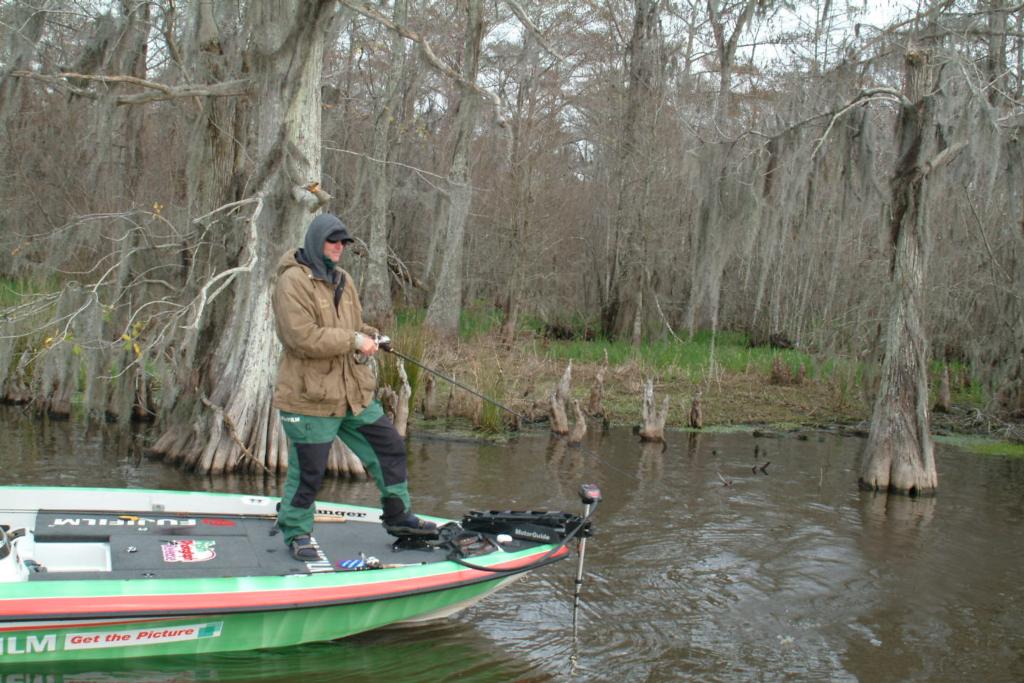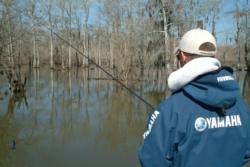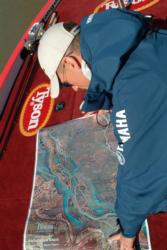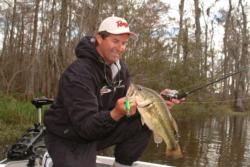Feast or famine at Atchafalaya Basin
Basin not as hospitable as last year

Last year, the Atchafalaya Basin welcomed the Wal-Mart FLW Tour with open arms. Extremely low water levels produced premium fishing conditions and the weather was decent – for February anyway.
This year the basin is not going to be as hospitable. Bass will still be caught, but there will be more disparity between those catching and those not catching.
Last year the ultralow water in the basin meant that the best fishing could be found near the official launch site at Belle River Landing. Anglers only had to travel 15 to 20 minutes to find plenty of fish.
 The rare water levels kept the cold, muddy river water from entering the hundreds of man-made canals. Bass were essentially trapped in the canals and their shallow-water homes were obvious to anglers. Places like the nearby Shell Oil canals and the Zig-Zag canals were productive. Even anglers who had never been to Atchafalaya before enjoyed great fishing.
The rare water levels kept the cold, muddy river water from entering the hundreds of man-made canals. Bass were essentially trapped in the canals and their shallow-water homes were obvious to anglers. Places like the nearby Shell Oil canals and the Zig-Zag canals were productive. Even anglers who had never been to Atchafalaya before enjoyed great fishing.
The basin will not be as generous or forgiving this year.
“I think the top-10 weights will be nearly the same as last year (top-10 cut weight was 27-1), but the weights won’t be as heavy down through the field; they will fall off a lot faster,” said Yamaha pro Greg Hackney of Gonzales, La. “The actual Atchafalaya Basin is about 2 to 3 feet higher than last year. That’s not to say it’s necessarily flooded, rather that it’s not at the extremely low levels of last year’s event. But with no contour in the basin, 2 more feet of water can look like a flood.”
“When the water comes up 2 feet in a reservoir, it’s not nearly as noticeable because the water is contained by banks,” said Tyson pro John Crews of Jetersville, Va. “But this place is basically a massive swamp with no banks. When the water comes up 2 feet here, the water floods way back into the swamp a quarter of a mile.”
 And when the water comes up, the fish go with it making them much harder to pinpoint. Also, with the higher level, muddy river water from the main tributaries is able to infiltrate into the protected canals.
And when the water comes up, the fish go with it making them much harder to pinpoint. Also, with the higher level, muddy river water from the main tributaries is able to infiltrate into the protected canals.
In order to find more productive water, pros will likely be making much longer runs this year. A general consensus among anglers is that fishing on the Lake Verret side of the basin’s flood-control dike is much better than it is in the basin itself.
That belief is somewhat supported by the results of a large tournament that put in on Lake Verret Sunday. The winning weight was just over 18 pounds for five fish, and there were seven teams that had at least 15 pounds. The 10th-place position was 13.68 pounds.
In addition, the water level on the Lake Verret side is lower and more stable, which usually means better fishing.
The only problem with the Verret side is that it requires running down the Intracoastal Waterway, locking through a barge lock on the dike and then running back up to Lake Verret and its adjoining canals.
If all goes well, the run take about one hour and 10 minutes; however, if there is a barge in or nearing the lock (as commercial traffic has priority), anglers could be stuck for a much longer period of time and risk disqualification for being late.
Another fishing option that pros will be entertaining this year is a run way south to the “marsh,” the estuarine part of the Atchafalaya Basin where it enters the Gulf of Mexico. In areas like Wax Lake and Bayou Black, winds and tides add to an already complicated puzzle of finding fish in these vast bays. Running south will take anglers about 45 minutes to an hour.
Also, anglers can make long runs to the west of Morgan City via the Intracoastal Waterway.
Either way, the long runs mean sacrificing two hours or more of fishing time.
 “I think anglers will be spread out much more than last year,” said Bernie Schultz of Gainesville, Fla. “Within each of those big areas – the basin, Verret, Wax Lake or Bayou Black – there will be small places holding lots of fish. The guys that find those places will have it made. It won’t be like last year where you could scratch around close by and put together a limit.”
“I think anglers will be spread out much more than last year,” said Bernie Schultz of Gainesville, Fla. “Within each of those big areas – the basin, Verret, Wax Lake or Bayou Black – there will be small places holding lots of fish. The guys that find those places will have it made. It won’t be like last year where you could scratch around close by and put together a limit.”
As of now, it does not look like the weather is going to be very kind to the 200 pros and 200 co-anglers in the event, either. Rain fell steadily throughout Tuesday’s final practice day and it’s not forecasted to let up until Thursday.
One thing that is going to be kind to anglers is the sizable Wal-Mart FLW Tour payout at the Atchafalaya stop. In addition to the top prizes of $100,000 going to the pro and $20,000 going to the co-angler, 50th place on the pro side will get $10,000. That means if a pro places in the top 25 percent of this event, he or she will be guaranteed at least $10,000. That’s enough motivation to get any bass angler out in a rain-soaked swamp to hunt a few keeper bass.
Weigh-in starts Wednesday at 3 p.m. Central time at the Belle River Boat Landing.